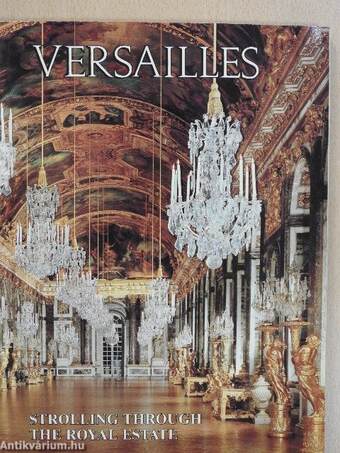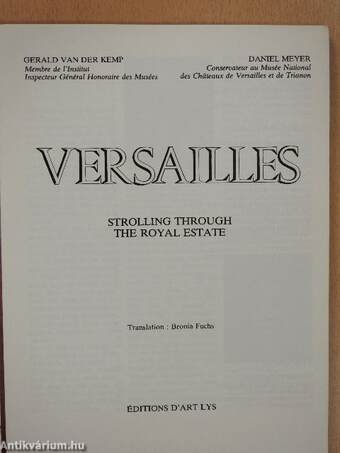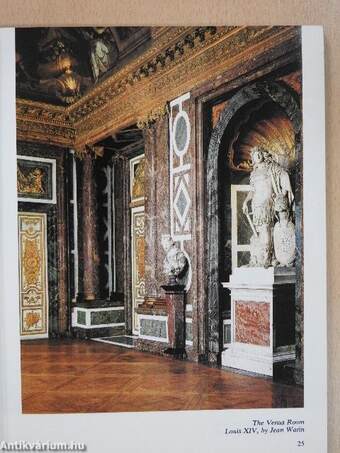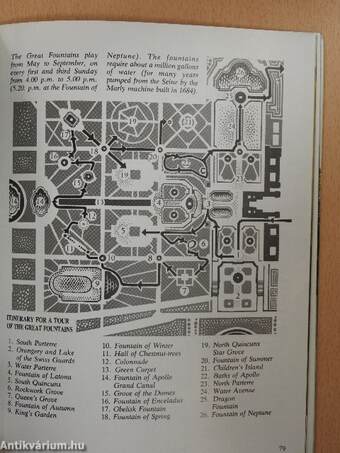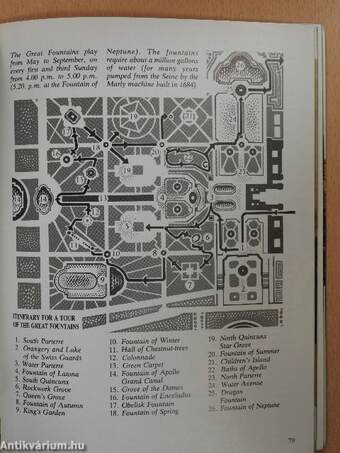1.063.231
kiadvánnyal nyújtjuk Magyarország legnagyobb antikvár könyv-kínálatát

VISSZA
A TETEJÉRE
JAVASLATOKÉszre-
vételek
Versailles
Strolling through the Royal Estate
| Kiadó: | Éditions d'Art Lys |
|---|---|
| Kiadás helye: | Versailles |
| Kiadás éve: | |
| Kötés típusa: | Fűzött papírkötés |
| Oldalszám: | 128 oldal |
| Sorozatcím: | |
| Kötetszám: | |
| Nyelv: | Angol |
| Méret: | 21 cm x 16 cm |
| ISBN: | |
| Megjegyzés: | Színes fotókkal, reprodukciókkal, fekete-fehér illusztrációkkal. További grafikusok a kötetben. |
naponta értesítjük a beérkező friss
kiadványokról
naponta értesítjük a beérkező friss
kiadványokról
Előszó
INTRODUCTION
This small guide to Versailles and Trianon is not intended as an exhaustive study of the most famous cháteau in the world. A large number of works and erudite articles on the... Tovább
Előszó
INTRODUCTION
This small guide to Versailles and Trianon is not intended as an exhaustive study of the most famous cháteau in the world. A large number of works and erudite articles on the subject already exist and much still remains to be said concerning details not only of the architecture of the cháteau but alsó of its interior decoration and the gardens. However, this has by no means been our aim in this booklet.
Our intention here is to offer an easily accessible work to guide the tourist in his visit to Versailles. It is for this reason that is seemed to us more important to discuss in great-er détail the apartments which may be visited freely than those of which guided tours are organized. As the Museum of French History is at present being reorganized, we have simply given somé generál information on this museum.
We did not wish, either, to give a detailed history of the cháteau's construction. A chronological table seemed to us to be far more useful and clear to the visitor tp Versailles. This introduction will simply bring out the uni-queness of this palace.
Louis XIII, the son of Henri IV, was born at Fontainebleau on 14'h September 1601. During his reign, royal authority was strengthened with the help of the chief minister, Richelieu. He died at Saint-Germain-en-Laye on 14,h May 1643.
Originally a small hunting pavilion erected in 1624 by Louis XIII who had it rebuilt in 1631, Versailles very soon attracted Louis XIV. The Sun King had construction work carried out on an increasingly large scale bet-ween 1661 and 1681. On 6th May 1682, he decided to make it the Court residence and seat of Government, which Versailles remained until 6th October 1789 when the royal family was forced by the Revolution to return to Paris and take up residence in the Tuileries. Versailles was, therefore, the capital of Francé for more than one hundred years; it was a veritable administrative city, with ministries and lodg-
ings for the Court officials. In fact, only the central sec-tion served as the King's residence. The south and north wings (with the Chapel and Opera attached to the latter) were reserved for the Princes and people holding office at Court. On either side of the Great Courtyard, the Ministers' Wings were the administrative centre; behind the south-ern Ministers' Wing were the lodgings for the King's per-sonal staff. The King's Stables and coachhouses stood opposite the cháteau, beyond the Royal Parade Ground. Other buildings were erected gradually as the need arose : the Directors' and Chancellor's Offices, the Queen's Stables.
Louis XIII's son, Louis XIV,
was born at Saint-Germain-en-Laye
on 5"1 September 1638-
After his personal reign which marked
the pinnacle of the French monarchy 's
glory, he died at Versailles
on 1" September 1715. Vissza
Tartalom
CONTENTS
INTRODUCTION 5
PLAN OF ENTRANCES TO THE ROY AL ESTATE 7
SEVERAL D ATES 8
GENERAL PLAN OF THE CHATEAU 10
THECHATEAU 12
THE ENTRANCE COURTYARDS 12
THE 17th CENTURY ROOMS 14
THEROYALCHAPEL 17
THE HERCULES ROOM 18
PLAN OF THE FIRST FLOOROF THE CHATEAU 20
THE STATE APARTMENT 22
THE HALL OFMIRRORS 32
THE QUEEN'S APARTMENT 35
THE CORONATION ROOM AND 1792 ROOM 43
THE HALL OFBATTLES 45
THE QUEEN'S STAIRCASE 47
THE KING'S APARTMENT 48
THE KING'S PRIVÁTÉ SUITE 54
Mme DE MAINTENON'S APARTMENT 64
THE QUEEN'S PRIVÁTÉ CABINETS 65
THE KING'S PRIVÁTÉ APARTMENTS 68
THE ROY AL OPERA 70
THE 18th CENTURY ROOMS 72
THE CONSULATE AND EMPIRE ROOMS 74
THE 19th CENTURY ROOMS 75
THE GARDENS 77
PLAN OF THE GARDENS 78
THE EAST-WEST AXIS 80
THE NORTH-SOUTH AXIS 92
THE GROVES 103
TRIANON 107
THE GRAND TRIANON 107
TOUR OF THE GRAND TRIANON 108
THE SMALL TRIANON 118
PLAN OF MARIÉ-ANTOINETTE'S HAMLET 124
GENEALÖGY I28
Témakörök
- Idegennyelv > Idegennyelvű könyvek > Angol > Művészetek > Építészet
- Idegennyelv > Idegennyelvű könyvek > Angol > Útikönyvek
- Útikönyvek > Európa > Nyugat-Európa > Városai
- Útikönyvek > Idegennyelvű útikönyvek > Angol
- Útikönyvek > Utazás, turizmus
- Útikönyvek > Természetjárás, túrák > Városnézés
- Művészetek > Építészet > Kontinensek szerint > Európa > Egyéb
- Művészetek > Építészet > Idegen nyelv > Angol
- Művészetek > Építészet > Műemlékek > Kastélyok



